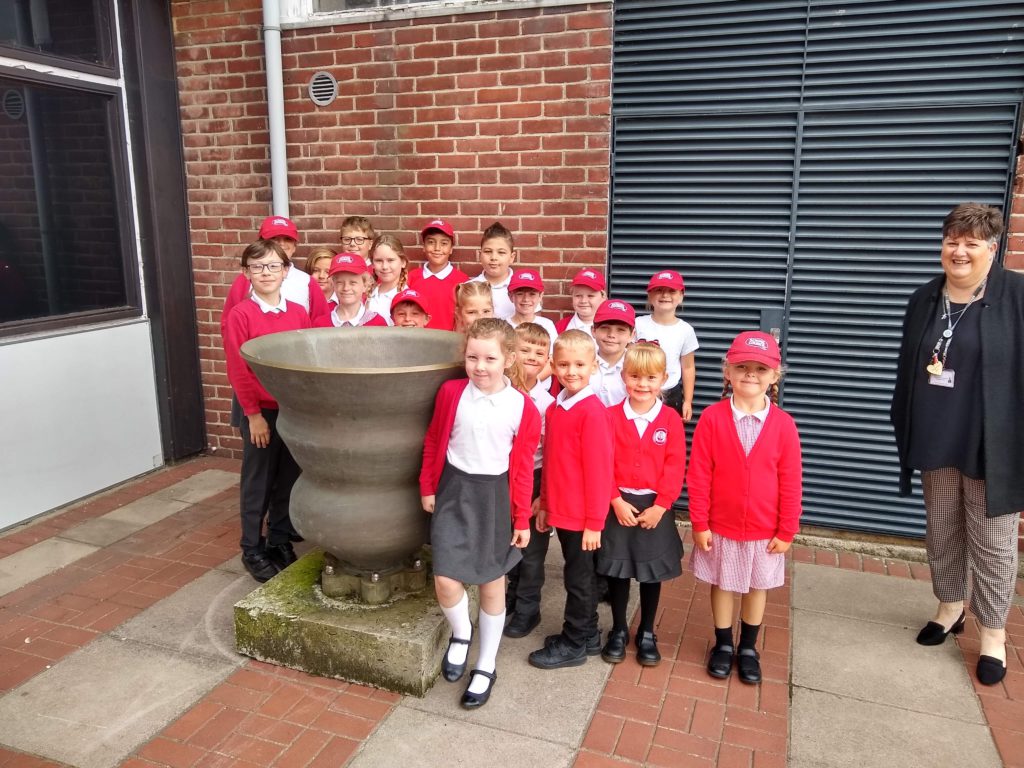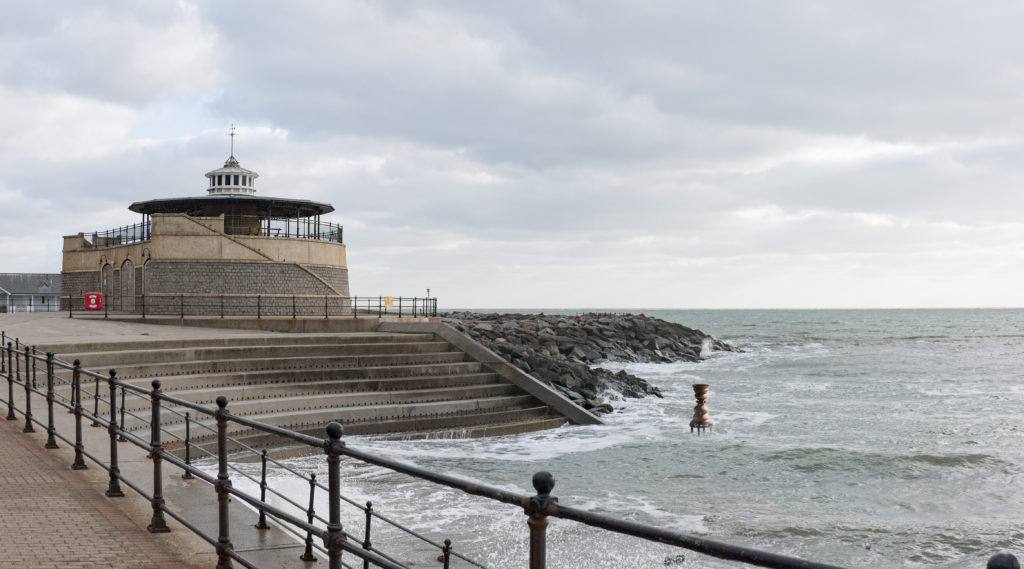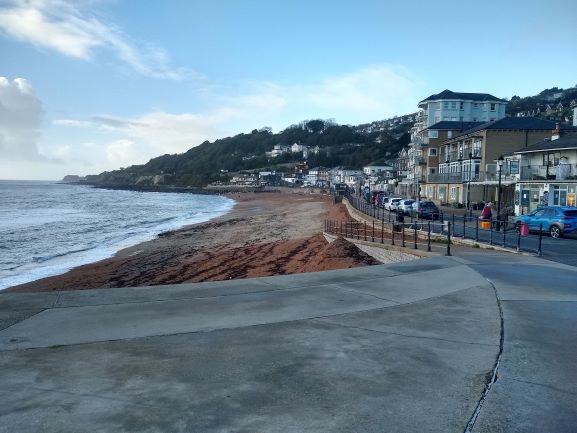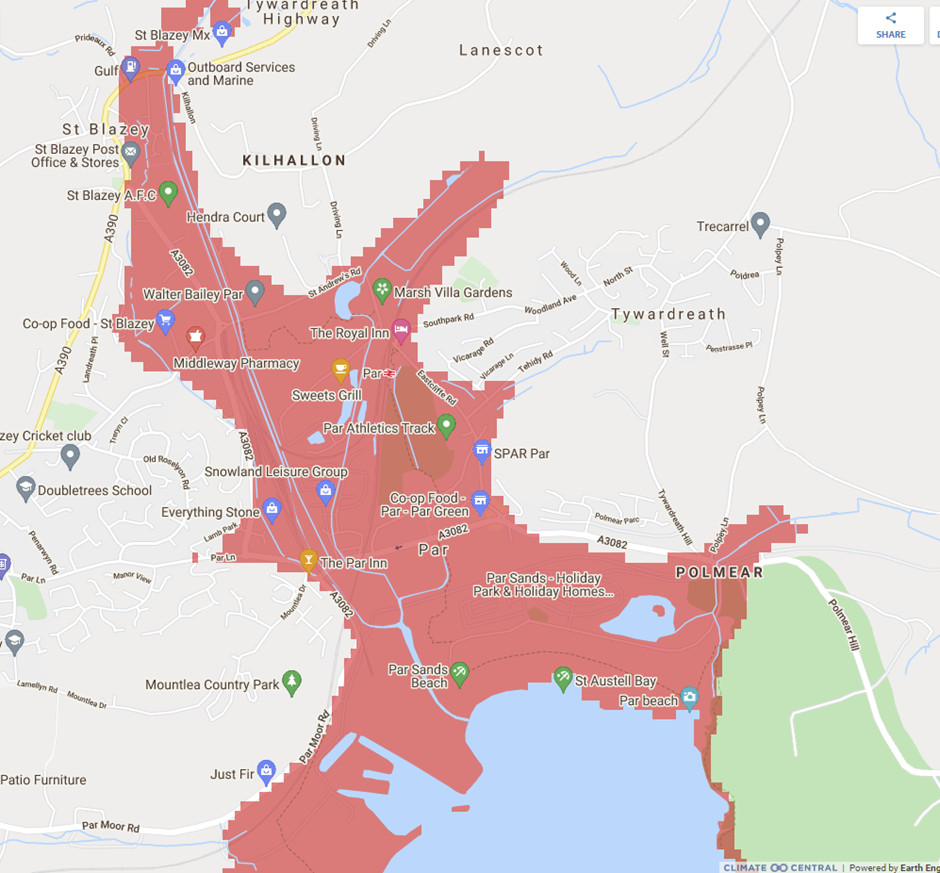Pete Moser ringing the bell on a chilly day at High Water Springs, January 5 2022.
In October 2021 we presented a half-bell to the Mayflower School, which is near where the bell will finally be sited at the Lower Lighthouse. Much enthusiasm!

On a windy day in Morecambe, Pete Moser rang out the bell for COP26. The same day that Barack Obama arrived in Glasgow....
With grateful thanks to Sue Atkinson here is an impression of the bell to be installed to the West of the Rotunda (itself hiding a sewage pumping station). It isn't installed yet - it just looks like it.....

Here's the view in the other direction (taken on a sunnier day).

This month Pete Moser is accompanied by Ben McCabe. For the non-initiated, Springs (the opposite of Neaps) is the highest tide of the month.
The wonderful performance we commissioned from Prodigal UPG has been touring to a few locations, including the Eden project, during the summer of 2021. The aim is that it should be performed at as many bell sites as possible in 2022. Here is a brief trailer.
Photographer Mark Kerton (whose YouTube channel is here), got up early to take these beautiful images of the Mablethorpe bell.
Pete Moser's playing of the bell at high water springs brings out its extraordinary harmonic properties this month.
The website Climate Central came in for a bit of stick from the BBC R4 programme More or Less on 1.7.21. It shows maps of the world together with their liability to flooding from sea level rise. On the site it looks as if most of Holland and surprisingly large areas of the UK will be under water on one of its default maps, 'Land projected to be below Annual Flood Level in 2050'.
We would be the last to want to understate the potential impact of sea level rise, but there is a lack of clarity here. The explanation lies in the fact that outside the USA, the site does not take account of existing or planned sea defences. However, that is exactly the situation in Par - it has no such, merely a low-lying beach, and there are no plans to build any; too costly. So although it is simply computer-generated from elevation data in Google maps, this image, taken from the site, may well be a reasonably accurate forecast of what will happen in due course given the coincidence of a storm surge and seas rising at 4.5mm per annum - or more.

Photos from throughout May.... One of the unusual features of the Morecambe Bell is that it only rings due to the waves at higher tides, those either side of springs.
The team in Par, among MANY other things, have put work into designing a logo for their bell. It follows our national approach - the same outline, but with colour ways chosen locally, for historic or other reasons.
At the centre of this design is the white cross on a black background, the flag of Cornwall.

It turned out that it would cost a great deal to create the foundations for the bell at the first site we looked at, on the spit of sand, shingle and mud that emerges at low tide.
On April 16 2021 a group visited all the most promising sites around the town. The most promising, extremely promising in fact, looks to be just off the Low Lighthouse - a location rich in history. The video shows its current name - the Maritime Museum.
Pete Moser and friend celebrate the highest tide in December 2020.Wrapped up warmer than in August , and with less wind. Thanks, all!
Marcus has completed an outline design for the installation in Par.

And the location is becoming clearer, in the fairway of the former river route.

It is shown slightly more clearly in this aerial photo - the location is marked with a red dot.

An excellent team is forming to drive things forward. Watch this space!
There is a real head of steam building for the new Isle of Wight bell to be in Ventnor, on the South Coast.The ideal location looks like being just south of the 'Rotunda' a circular building atop a pumping station, sandwiched between the town's beach and Ventnor's small harbour.

The bell would be mounted among the rocks to the right of the photo above.

A fantastic team has formed to progress things, some of whom are present in this photo of the rough location for the bell.
Nasa has just launched a new satellite to measure sea level rise, charmingly named after a recently deceased scientist, Sentinel-6 Michael Freilich.

Long story short, here's Nasa's graph of sea level rise as measured by satellites to date:

It's rather a challenge to know how to feel about this.....
The proposed location for the Harwich bell is on a spit of sand that runs out from the beach. Obviously the bell will need a strong foundation - and so there needs to be an investigation of what is going on underground - core drilling.
On October 23 Tendring District Council engineers brought along a drilling rig. It turns out that you have to go down 12 meters to find something solid. So the bell will have to be mounted on a quite substantial pile.
Horribly delayed from the proposed installation in July 2020, the bell has finally been delivered to Marcus Vergette's studio from the foundry.

Can it still be installed this year? Watch this space.
The Mablethorpe bell is the only one mounted on a beach. It is fixed to large 'helical piles', which like large corkscrews are driven deeply into the sand; this is a common way of mounting structures on sand.

Anyone who has visited the bell may have noticed various levels of the sub-structure being revealed by shifts in the sand level. It seems that when the bell was installed the sand was at a relatively high level. but for various reasons it has changed: natural seasonal variations, the impact of large scale sand pumping just off shore, and more.

This necessitated some remedial work early in 2020.

But since then the level has risen. Time will tell where it ends up.....
After a grievously long interval - given that our first toe in this water was in early March, we are striving to put momentum back into this project. The Marine Biological Association has come out of lockdown, fuloughs are over, and all we have to do is pick up where we left off (as though that were easy).
The next step is to contact all our intrepid volunteers from March and plan some activity,, which should be in the middle of October.
We have firmly mailed our colours to the iNaturalist mast, and have set up three projects on that excellent platform. And we have set up three 'projects' on it, as illustrated below.

This is the link to the overall project, and here are links to the Appledore, Morecambe and Mablethorpe projects.



